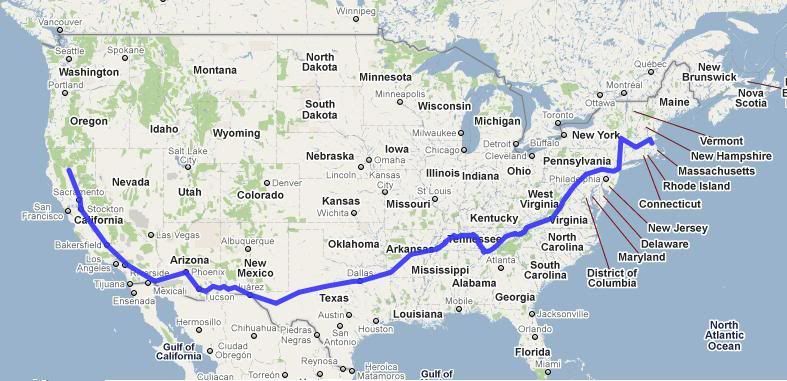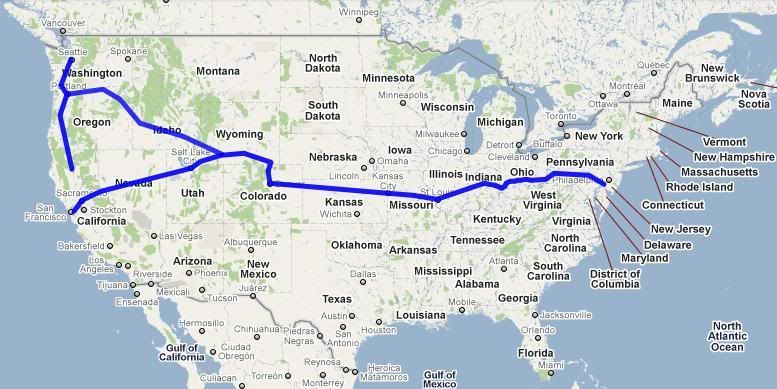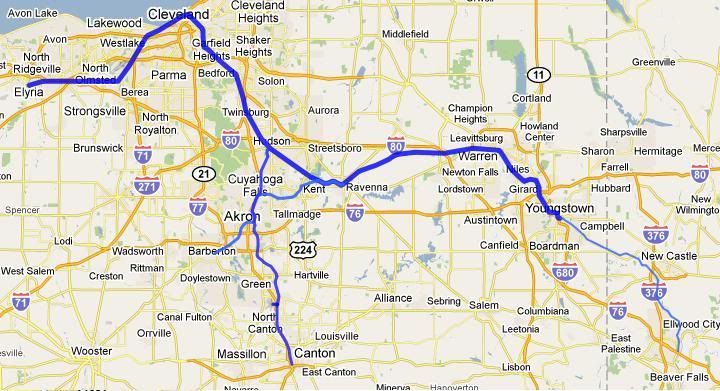(2 pm. – promoted by ek hornbeck)
Burning the Midnight Oil for Living Energy Independence
 I’ve written several times about the direct potential of the Steel Interstate project to cut our oil imports by 10% by getting long haul freight trucking off the road. It would at the same time relieve the crushing burden imposed by long haul trucking on our over-worked, under-maintained Interstate, National and State highways, help get renewable energy resources from places that they are to places people need electricity, and of course support long distance Rapid Passenger Rail offering dramatically improved reliability and transit speed, supporting operating surpluses with multiple services per day.
I’ve written several times about the direct potential of the Steel Interstate project to cut our oil imports by 10% by getting long haul freight trucking off the road. It would at the same time relieve the crushing burden imposed by long haul trucking on our over-worked, under-maintained Interstate, National and State highways, help get renewable energy resources from places that they are to places people need electricity, and of course support long distance Rapid Passenger Rail offering dramatically improved reliability and transit speed, supporting operating surpluses with multiple services per day.
I don’t recollect that I have written very much about the benefit that the Steel Interstates offer to passenger rail elsewhere. So that’s what I aim to do. Today I will look at one rail transport ideas I have talked about previously ~ Northeast Ohio Regional Rail ~ and what help it would receive from the Steel Interstates. Then sometime in the next week or two, I will look at the Columbus / WV / Atlantic Coast “RidgeRunner”, and the benefit it would receive from the Steel Interstates.
The Steel Interstate Concept
First to introduce Steel Interstates for new Sunday Train passengers (and refresh the memories of old hands). The Steel Interstates are publicly owned rail infrastructure that provides the upgrades to existing Dept. of Defense Strategic Rail Corridor NETwork (STRACNET) rail lines to allow 100mph freight trains to operate high reliability schedules, and overhead electric catenary infrastructure to power electric trains trains on both the existing and new track.
The Rapid Freight Rail allows trucks to haul container freight to origin and from destination marshaling yards, with the container hauled at high speed in between, and provide better loading dock to loading dock transit time than a direct long haul truck. The 90%+ improvement in energy efficiency running by electric rail compared to diesel trucks offers both commercial benefit in addition to substantial reduction in oil addiction.
The overhead electric catenary support structures are built to also be able to carry High Voltage Direct Current “Electricity Superhighway” long distance grid to grid power ~ at roughly 5% losses per 1,000 miles ~ to allow these lines to take advantage of the Steel Interstates anywhere along the corridor it may be of use, either now or in the future.
The public finance of the Steel Interstates consists of some dedicated source of funding for interest rate subsidies, with the original capital cost of the system refunded by the user and access fees paid by the users.
I organized the Steel Interstates into four distinct “Lines”, each of which would be developed by a “Line Development Bank”:
- The Liberty Line from Boston to California via the Shenandoah and Tennessee River Valleys, through to Texas and the Southwest;
- The National Line, from Delaware through through the middle of the country to St. Louis, Denver and Salt Lake City, then forking to San Francisco and the Pacific Northwest;
- The Gulf and Atlantic, along the Atlantic and Gulf Coasts, forking to El Paso and Denver; and
- The Heartland, with two legs, from NOLA along a north by northeasterly alignment to Buffalo and Toronto, Canada, and Miami along a north by northwesterly alignment through Chicago, Minnesota, and Winnipeg, Canada.




OK, So What Good is that For Canton and Akron, Ohio?
Now, imagine proud lines-on-a-map drawer showing these maps to an honest upstanding resident of west Akron. They would, naturally enough, look to puzzle out where Akron is on that map. “Wait, does that Heartland there run up through Akron or Canton?”
Hmmm. I squint, “Oh, no, the high quality alignment for a Rapid Rail corridor runs from Elyria, west of Cleveland, down to Columbus. I guess that is somewhere near Wooster or Mansfield, on its way to Cleveland.”
“Wooster? MANSFIELD?? What use is that?”
There is one line of discussion, which is to point out that everyone benefits from the trips taken on electric Rapid Passenger Rail trains between Cleveland and Columbus, or Buffalo and Cleveland, or Cincinnati and Chicago, because otherwise that would burn gasoline or jet kerosene, and we don’t have enough of those for our needs. You can look on multiple Sunday Train pieces that frame the Steel Interstate in terms of Oil Addiction or Climate Chaos as a discussion along that line.
There is also the following line of discussion, however. All we need to get a HSR route from the East Coast through Pittsburgh through Youngstown and Portage County through to Cleveland is to fill in the gap between Pittsburgh and Cleveland. Indeed, we could run a train from Youngstown to Cleveland to Columbus just by adding the bit between Youngstown and Cleveland.
“So, does that run through Akron?”
Well, it runs through Hudson, in the extreme northeast end of Summit County. But having that intercity corridor ~ that is the hook for providing a local train from Canton through Akron to Cleveland, and from the HSR corridor east of Kent, through Kent, and Akron, and Akron University, to Barberton.
With a station, say, right over yonder.

See, the alignment that runs through from Pittsburgh through Youngstown to Cleveland misses both Kent State and Akron University. But there are rail corridors running every which way in this part of the country, and because these towns and cities grew to their present size due to rail, there is an alignment that runs from the branch line to be used by the HSR corridor, through Kent, past the mall at Cuyahoga Falls, through Akron, past Akron University, and out to Barberton.
It’s not very useful as an intercity corridor ~ but if it connects to a 110mph Rapid Passenger Rail corridor, it connects into intercity transport ~ direct access to Cleveland and Pittsburgh, flight connections at those airports, rail connections west to Chicago, east to the East Coast.
With the connections at the HSR corridor through the day, connections to several city and town centers and a major regional shopping center, this is more than just a “commuter line”.
And after this line is in place, the platform has been laid to run a Canton/Akron line through to Cleveland. For this rail corridor, only the Akron / Canton section needs to be done, as the northern part of the route is already finished. And with a “through terminal”[*] station at Canton-Akron airport.
{[*] A terminal because that’s required to get FAA funding, a “through” terminal because the southbound train turns into the airport line, the driver gets out and gets into the opposite side to take the train back out, and when it gets to the main rail corridor keeps going south.}
And of course, it is a problem of any Akron/Canton alignment that it can’t run directly through Akron University or Kent State, and by the same token a problem of any alignment through Kent State and Akron U. that it can’t run to the airport ~ but the connection between the two lines at the main shopping center at Cuyahoga Falls provides connections to all.
Both of these local lines are difficult to imagine as projects to be pursued in today’s Ohio. Even though both would offer substantial transport benefits to local residents, especially in the coming days of $6~$8/gallon gas.
But imagine the context of intercity trains running at speeds competitive or faster than driving from Philadelphia to Pittsburgh and from Buffalo through Cleveland, Columbus and Cincinnati through to Nashsville, Atlanta and New Orleans. In that context, connecting Pittsburgh and Cleveland by Rapid Passenger Rail is a straightforward project.
And then put Akron and Canton in that context, and these local rail corridors are much easier to imagine. Indeed, because the main intercity corridors would be profitable when running on the Steel Interstate, coming up with the state matching funds for investment in local rail is only a matter of insisting that those profits get rolled back into transport investment in counties without these services running through.
So? What Good does Any Of That does for West Virginia?
Now, I hope in my train of imagination and roll on down to Charleston, West Virginia.
“Yeah, sounds good for people in cities. Yet one more way for cities to soak up all the transport money so Appalachia is once more stuck without.”
And ~ well at first blush, fair enough. It took until the 60’s to bring the severe under-provision of passable roads in Appalachia to public notice, and just as those roads get finished, we find that we have to move to oil-independent transport, leaving Appalachia once again out in the cold.
But I don’t really think its so on closer consideration, so that it where I will pick up the story when I finish this topic.
Midnight Oil ~ Truganini

9 comments
Skip to comment form
Author
… not Akon
Author
… not Akon …
Author
… not Akon …
But the oligarchs oppose it so it won’t happen. I suspect that they’re saving their investment money for other places, other times, other societies. I think the U.S. has been written off and will be allowed to decay as it’s clearly doing. Americans seem to think it’s ok.
BTW, I love trains and always have–they are the most sensible form of transportation we have right now.